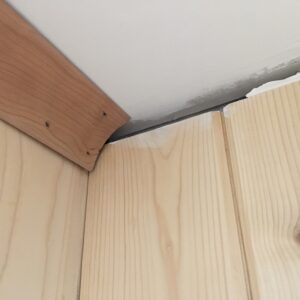Question on using shop made cove moulding as crown moulding
I know how to cope standard crown moulding to install a standard inside corner. Standard crown moulding has 2 angles that meet the wall and ceiling equaling 90 degrees. I do not know what the are but a 45 degree cut and cope out the waste works. The cove moulding that I made (see pictures) is 3/4 of inch thick and 2 1/8 inches wide. The back side bevels are both 45 degrees. I found some charts that spoke of finding the “Spring Angle” but was not specific enough for me to figure out how that translated to setting up my miter saw once I knew the angle. Thanks in advance.


















Replies
Store bought crown has 3 different angles. These refer to the flat back of the crown in relation to the wall, and the ceiling, which together must equal 90 degrees. Both those angles can be 45. The angle on the wall can be 38, and the ceiling angle 52. Or the wall angle can be 52, and the ceiling angle 38.
You can make your own crown and have any angles you want. But the stops on miter saws are set up to cut crown, when flat on the saw table, only at those store bought spring angles.
You could figure the angles for your saw if you were cutting, say 30/60 crown. But that's a pain.
I always cut crown standing up, as if the table and fence were the wall and ceiling. Then it's just a 45 degree left or right miter.
That's how I would cut your homemade cove.
I have to admit, I'm not sure what you are asking? Spring angle is nothing more than the angle of contact with the wall. In your case that would be 45°.
If you are asking how to cope your inside corners just cut a 45° inside miter and cope to the edge where the miter meets the face. How you do this depends upon your saw and preferred method. If you have a compound miter saw you can lay the molding flat and bevel it at 45 degrees. If not or you just prefer to cut crowns on miter versus a bevel you can just hold it against the table and fence at a 45° angle and miter the cut. Depending on your saw this may require a jig to maintain a consistent angle.
What @John_C2 said.
I find this such a headache that I use the mitre saw corner between the table and the fence as my 'ceiling corner' - you have to think upside-down but it's still WAY easier than trying to work out angles. Fix the moulding down then cut it effectively in-situ.
I also find working out lengths difficult, so cut a little oversize and sneak up on the fit.
Agree with John, but I add a jig made of thin (1/2") material to the bed of the saw and a "fence" as a guide/stop. This makes it easy to hold the molding against the fence so it does not slip. I drilled and tapped the bed and countersunk a couple of screws in th ewood to hold it in place. I recently did about 200' with not a slip.
My bad. I figured it out. I was over complicating this after a few cuts went wrong. Thanks for the replies.
This forum post is now archived. Commenting has been disabled